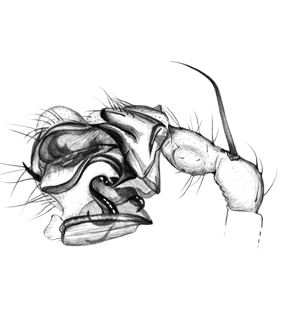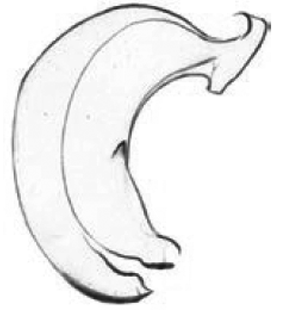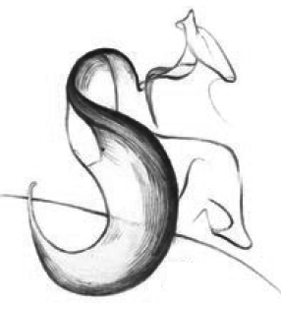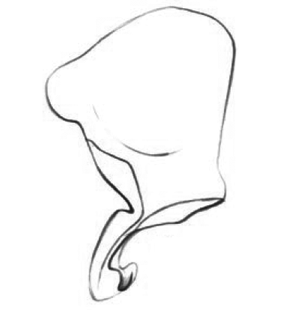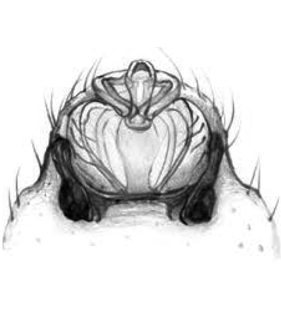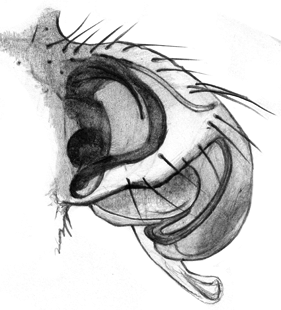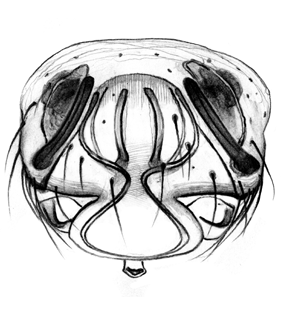Troglohyphantes cyrnaeus Isaia, 2023
Description
Male
Prosoma 1.13 long, 0.95 wide (measured between coxa II and III), yellowish. Thoracic region very slightly swollen, yellowish. Cephalic region slightly elevated, interspersed with black bristles between the eyes, with few small black bristles around the eye region and continuing backward in 2 longitudinal rows converging at the thoracic furrow. Cephalothorax height measured at the eye region from clypeus base to the top of the profile: 0.30. One bristle just below AME. Carapace uniform in colour. Clypeus convex, 0.20 long. Eyes small, lacking pigment. PME barely visible and AME very small. ALE and PLE bigger than AME and PME. ALE and PLE contiguous. PLE–PME distance = 0.07, ALE–AME distance = 0.07, PME–PME distance = 0.11. Eye diameters AME 0.01, PME < 0.01, ALE 0.04, PLE 0.03. Sternum heart-shaped, yellowish. Chelicerae light brownish, 0.57 long (from the inferior margin of the clypeus to the fang), with ca. 35 lateral stridulatory ridges barely visible and armed with 3 anterior and 2 posterior teeth. Legs yellowish, uniform in colour. Leg I: femur 2.93, patella 0.42, tibia 3.20, metatarsus 2.96, tarsus 1.65, TLL 11.18; leg II: femur 2.66, patella 0.43, tibia 2.76, metatarsus 2.42, tarsus 1.33, TLL 9.60; leg III: femur 2.23, patella 0.40, tibia 2.04, metatarsus 1.85, tarsus 1.02, TLL 7.54; leg IV: femur 2.66, patella 0.40, tibia NA, metatarsus NA, tarsus NA, TLL NA. Opisthosoma grayish with darkened distal pattern, 1.41 long, 0.80 wide. Palp: femur 0.80, patella 0.21 tibia 0.24. Cymbium complex, proximo-mesal part incised about half way. When seen from above, anterior margin rounded, external margins sinuous, deeply incised half way. Internal margin straight, converging almost perpendicularly at two thirds of its length. When seen from above, the proximal part of the cymbium bears a narrow apophysis directed externally and converging at its very end in a crochet-hook shaped apophysis directed towards the median axis of the cymbium. The proximal apophysis of the cymbium covers approximately one third of its total length. Posterior part of paracymbium subrectangular, apical part narrowed anteriorly. Lamella significativa visible in lateral view without extraction, S-shaped, distally tapering and ending with a small and sharp hook headed backward. Suprategular apophysis directed upwards, with a sharp end. Tip of the embolus spiky.
Spination: Femur I with 2 prolateral spines; Femur II–IV with no spines. Patella I–IV with 1 dorsal spine. Tibia I with 2 dorsal, 2 retrolateral, and 2 prolateral spines (on the ventral side several weak spines are present); Tibia II with 2 dorsal (same as for Tibia I on the ventral side), 1 retrolateral, and 1 prolateral spine; Tibia III with 2 dorsal and 1 retrolateral spines; Tibia IV NA. Metatarsus I with 1 dorsal and 2 prolateral spines, Metatarsus II-III with 1 dorsal spine, Metatarsus IV NA. Tarsus with no spines. Patella of the palp with 1 long, curved spine. Position of TmI: 0.17. Trichobothrium on Mt IV absent.
Female
Prosoma 1.35 long, 1.01 wide, colouration similar to male (some females are darker). Cephalic region yellowish. Carapace, ocular area, clypeus, and sternum are similar in all features to the analogous male body parts. Cephalothorax height measured at the eye region from clypeus base to the top of the profile: 0.40. One bristle just below AME. Carapace uniform in colour. Clypeus convex, 0.20 long. Eyes small, lacking pigment. PME almost visible and AME very small. Anterior margin of the chelicerae armed with 3 teeth. Clypeus 0.15 long, chelicerae 0.67 long. PLE–PME distance = 0.09, ALE–AME distance = 0.09, PME–PME distance = 0.11, AME–AME distance = 0.01, ALE–PLE distance <0.01. Eye diameters: AME 0.03, PME 0.02, ALE 0.04, and PLE 0.04. Abdomen grayish, 1.90 long, 0.95 wide. Leg I: femur 2.98, patella 0.42, tibia 3.22, metatarsus 2.77, tarsus 1.58, TLL 10.97; leg II: femur 2.75, patella 0.43, tibia 2.82, metatarsus 2.49, tarsus 1.42, TLL 9.91; leg III: femur 2.37, patella 0.42, tibia 2.16, metatarsus 1.94, tarsus 1.03, TLL 7.92; leg IV: femur 2.97, patella 0.42, tibia 2.84, metatarsus 2.56 tarsus 1.41, TLL 10.2. Female palp: femur 0.72, patella 0.11, tibia 0.36, tarsus 0.63, total palp length 1.82.
Epigyne large and strongly protruding, epigynal plate forming a triangular scape, wider than long, narrowed at its base, and progressively enlarged distally. Posterior margin of the anterior plate almost straight then bending almost perpendicularly, margins not deeply incised, the height of the anterior plate in the middle greater than the total height of the scape. Lateral plates clearly visible in ventral view, parallel to the lateral margins of the scape and not reaching the posterior end of the epigyne. Scape arched from a lateral view, covering entirely the inner part of the epigyne; stretcher tongue-shaped, short, bent upwards towards the scape, bearing a pitted knob at its end, clearly visible from a ventral point of view and emerging halfway in the profile in lateral view. Fertilization ducts sclerotized.
Spination: femur I with 2 prolateral spines; femur II–IV with no spines, patella I–IV with 1 dorsal spine, tibia I with 2 dorsal, 3 retrolateral, and 3 prolateral spines (ventral spines same as males); tibia II with 2 dorsal, 2 retrolateral, and 3 prolateral spines (ventral spines as in males); tibia III with 1 prolateral, 2 dorsal, and 2 retrolateral spines; tibia IV with 1 dorsal, 1 prolateral and 1 retrolateral spines; metatarsus I–IV with 1 dorsal spine; palp with no spines on femur, 1 long curved spine on patella, 1 prolateral and 1 dorsal on tibia, approximately ten spines on tarsus. Position of TmI: 0.17. Trichobothrium on Mt IV absent.
Additional information
troglobiont, exclusively known from the type locality
Distribution
Phenology
| Jan | Feb | Mar | Apr | May | Jun | Jul | Aug | Sep | Oct | Nov | Dec |
 |  |
Figures
Distribution List
"No references" does not mean that the species does not occur in this country, but that we have not yet inserted the reference for it. We are working on it.
References
Isaia M, Mammola S, Arnedo M A (2023a) A relict subterranean spider (Araneae: Linyphiidae: Troglohyphantes) reveals a unique component of the biogeography of Corsica. Insect Systematics and Diversity 7(3, 2): 1-16 ![]()
WSC (2024) World Spider Catalog. Version 25.5. Natural History Museum Bern, online at http://wsc.nmbe.ch (31.10.2024) doi: 10.24436/2 ![]()
